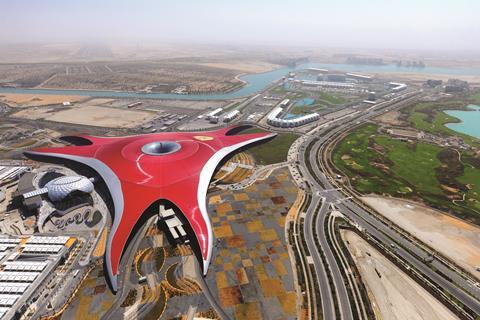Curtain walling encompasses many construction types and materials. This module, sponsored by Reynaers, provides guidance on the different aluminium systems available and their various merits

How to take this module
UBM’s CPD distance-learning programme is open to anyone seeking to develop their knowledge and skills. Each module also offers members of professional institutions an opportunity to earn between 30 and 90 minutes of credits towards their annual CPD requirement.
This article is accredited by the CPD Certification Service. To earn CPD credits, read the article and then click the link below to complete your details and answer the questions. You will receive your results instantly, and if all the questions are correctly answered, you will be able to download your CPD certificate straight away.
CPD CREDITS: 60 MINUTES
DEADLINE: 1 DECEMBER 2017

INTRODUCTION
This CPD will focus on different types of aluminium curtain walling. The Centre for Window and Cladding Technology (CWCT) defines a curtain wall as “a form of vertical building enclosure which supports no load other than its own weight and that of ancillary components and the environmental forces which act upon it”. Although the term is sometimes restricted to metal framed curtain walls, the above definition embraces many different construction methods and materials including non-loadbearing precast concrete.
CWCT Technical Note 14 refers to the following types of aluminium curtain wall:
- Stick
- Unitised
- Structural glazing
- Panellised
- Spandrel panel ribbon glazing
- Structural sealant glazing
The two main types of system are stick and unitised. In a stick system, vertical profiles (mullions) run the whole height of the facade and horizontal profiles (transoms) are then positioned in between them. The profiles are prepared and cut to the correct size in the workshop but most of the work, including the glass installation, is carried out on site.
Unitised systems differ as the panels – which consist of the profiles, glass, accessories and gaskets – are manufactured in the workshop and are then transported to site for final installation.
Curtain walling products are usually referred to by their profile – or frame – face width. Very slimline systems exist, as thin as 35mm, but the most common profile is 50mm. In a typical 50mm system, the face width of the cap and the main rear profile are both 50mm. Larger frames with a wider face width can be used where greater glass coverage is required.
STICK CURTAIN WALLING
Components of a stick system
A typical stick curtain walling system will consist of the following parts:
- Structural element (back box). This is generally a box-type section to provide support for loads.
- Jointing. A suitable method of connection between the mullions and transoms transfers loads from the former to the latter. This is through use of an anti-rotation (spring) pin or a shear block.
- Sealing. All joints and components must be sealed with an appropriate joint sealer. This is often critical to the curtain wall’s performance.
- Capping. This is an aesthetic section that defines the appearance of the external face. It can easily be designed to meet the architect’s needs.
- Glazing rebate. This is a channel designed to retain the panels. It is generally formed by a rebate and pressure plate.
- Drainage. In a dry glazing curtain wall, the system will be designed with suitable pressure-equalised drainage paths to accommodate the ingress of water past the first line of gasket defence. If the water does get past the gasket, it runs into the horizontal face cap and can either drain through slots in the bottom of the cap or drain into the mullion.

Opening types
Most curtain wall products are offered with different opening options, such as top-hung, tilt-and-turn and flush roof vents. Other possibilities include the concealed vent, which is invisible from the exterior of the building. This gives the advantage of a consistent facade without increased sightlines. Parallel openers, meanwhile, are windows that open on all four sides, extending away from the facade, potentially increasing airflow. Top-hung and parallel opening vents can be manual or automated depending on their size and weight.
Advantages and restrictions of a stick system
A stick system can offer a number of benefits, including aesthetic quality and versatility:
- Because they are used frequently, there are a large range of standard solutions
- Slim frames can often be achieved, minimising sightlines, maximising exterior views and allowing maximum natural light
- They can be used in roof applications and vertical facades
- Minimal workshop space is required as most of the work is carried out on site, although the aluminium is prepped and cut in the factory beforehand.
There are also certain restrictions:
- Scaffolding is required for the installation, so it is important that there is adequate space on site to carry out the installation safely
- More work takes place on site so a relevant timeframe must be allowed.
Variants on the stick system
Common variants of stick curtain wall systems include the following:
- High insulation (HI), for higher thermal performance
- Structurally clamped (SC), gives a seamless exterior finish
- Structurally glazed (SG), as above but cassettes can be pre-glazed (partially unitised)
- Slimline (SL), for slimmer external and internal capping
Table 1 shows some of the key differences between the variants – such as the visible width of slimline and structurally glazed options, and the glass thickness of high-insulation systems.
| Style variant | 50mm system | High insulation | Slimline | Structurally clamped | Structurally glazed |
|---|---|---|---|---|---|
|
Interior visible width |
50mm |
50mm |
15/50mm |
50mm |
50/88mm |
|
Exterior visible width |
50mm |
50mm |
50mm |
Joint: 20mm 50mm sightline |
EPDM gasket (w 27mm) 88mm sightline |
|
Depth of mullions |
42-300mm |
42-300mm |
126-168mm |
42-300mm |
42-300mm |
|
Depth of transoms |
5-193mm |
5-193mm |
88-172mm |
5-193mm |
5-193mm |
|
Inertia of mullions (Ix: wind load)1 |
14-2,690cm4 |
14-2,690cm4 |
160-381cm4 |
14-2,690cm4 |
14-2,690cm4 |
|
Inertia of transoms (Ix: wind load)1 |
0.4-551cm4 |
0.4-551cm4 |
73-436cm4 |
0.4-551cm4 |
0.4-551cm4 |
|
Inertia of transoms (Iy: glass load)1 |
3-57cm4 |
3-57cm4 |
9-23cm4 |
3-57cm4 |
3-57cm4 |
|
Exterior face caps |
Different shapes available |
Different shapes available |
Different shapes available |
Not applicable |
Not applicable |
|
Glazing |
Fixing by pressure plates |
Fixing by pressure plates |
Fixing by pressure plates |
Clamped solution |
Structural glazing glued on cassettes and clamped to grid |
|
Rebate height |
20mm |
20mm |
20mm |
Structural sealed glazing |
Structural sealed glazing |
|
Glass thickness |
6-62mm |
6-62mm |
6-62mm |
27-63mm |
24-36mm |
|
Opening types2 |
1,2,3,4,5 |
1,2,3,4,5 |
1,2,3,4,5 |
1,2,3,5 |
1,2,5 |
|
Roof application |
Yes |
Yes |
Yes |
Yes |
Yes |
1 Wind load refers to the deflection inwards and outwards on the face of the facade, glass load refers to the downwards load resulting from the glass unit.
2 1 = top-hung, 2 = parallel opening, 3 = concealed vent, 4 = flush roof vent, 5 = integration of other products such as entrance or sliding doors.

UNITISED CLADDING SYSTEMS
Advantages and restrictions of unitised systems
A key characteristic of a unitised system is that the panels are pre-assembled in the workshop. The panels consist of the framing, glass, accessories and hardware. There are several key advantages to this during installation:
- The workshop can offer a more controlled environment, improving quality as well as health and safety.
- Fabrication can be planned and controlled: standardised fabrication reduces processing defects.
- Less time is required on site.
- There is no need for scaffolding because a mobile elevator or crane is used to install the panels from the inside of the building. Workers guide the panels into place wearing suitable safety equipment and harnesses.
- The installation can be completed one floor at a time, allowing internal works to take place at the same time.
There are also advantages in other areas:
- The product can be adapted to deal with building movements and dilations.
- There is limited transfer of impact noises from floor to floor as the profiles do not run continuously through the length of the facade.
- The facade is not just limited to glazed panels. Other materials can be incorporated, such as feature panels.
- Bespoke solutions can be tailored to specific projects. For example, 30 new profiles, 12 new gaskets and countless fittings were designed specifically for the Ferrari World theme park in Abu Dhabi. These kinds of complete tailor-made solutions are rare, however, because it is often possible to make relatively small adjustments to existing systems.
Some restrictions do have to be taken into consideration when specifying unitised systems. For example, the workshop must have sufficient space and be properly equipped with specialist equipment. Transportation of the pre-assembled units must be factored in. And specialist equipment, such as a crane or mobile elevator, is required on site in order to lift the panels into place. All of these necessitate some investment on the part of the fabricator and/or installer.

AESTHETIC CONSIDERATIONS
A number of aesthetic effects can be achieved with the use of curtain walling, either with or without an exterior cap. If a capped solution is required, a host of options are available in the standard ranges. An uncapped solution enables a smoother and more seamless exterior appearance.
It is also possible to create a bespoke solution, but this will have an impact on cost, so feasibility may depend on the scale of the project.
Colour
Different colour options are available from all aluminium systems companies. RAL colours are standard and allow the specifier to choose from a wide selection of colours, and between matt and gloss finishes.
Other specialist finishes include anodisation and Coatex. Anodisation is an electrochemical process that forms a protective coating of aluminium oxide on the surface of the aluminium. The coating is integral to the metal and cannot peel or flake. It allows for a harder surface, which may be more suitable for high-traffic applications. A disadvantage is that the process can lead to variances in colour.
Coatex is a textured paint finish that is available in a wide selection of colours and is more scratch-resistant than a traditional RAL finish.
STANDARDS
There are various regulations and standards that should be consulted when specifying curtain wall products. These include:
- Building Regulations. Relevant parts when specifying curtain walling are Part F – Ventilation, Part L – Conservation of Fuel and Power, and Part N – Glazing, Safety in Relation to Impact, Opening and Cleaning.
- BS EN 13830. This is the European standard for curtain walls and forms the product standard in reference to the Construction Products Regulation for CE marking.
- CE marking covers all legal requirements prevailing in EU member states. It is applied to finished products and does not extend to installation or erection. The fabricator is ultimately responsible for this and will ensure all products are marked accordingly. The CE label is a passport which declares that the product may be put on the European market. Most curtain wall system suppliers should be able to provide a CE passport that includes the data required for the Declaration of Performance (DoP).
- The CWCT Standard for Systemised Building Envelopes. This acts as a comprehensive guide to all aspect of performance that should be included in an envelope specification. It helps specifiers to choose classes of performance appropriate to the UK climate when using European test methods and comply with UK Building Regulations. It also supports them to ensure appropriate communication between different designers and contractors and set appropriate standards for finish and appearance.
For additional information on standards applicable to aluminium curtain, see the CAB Standards & Regulations List February 2016 available at www.c-a-b.org.uk.

How to take this module
UBM’s CPD distance-learning programme is open to anyone seeking to develop their knowledge and skills. Each module also offers members of professional institutions an opportunity to earn between 30 and 90 minutes of credits towards their annual CPD requirement.
This article is accredited by the CPD Certification Service. To earn CPD credits, read the article and then click the link below to complete your details and answer the questions. You will receive your results instantly, and if all the questions are correctly answered, you will be able to download your CPD certificate straight away.
CPD CREDITS: 60 MINUTES
DEADLINE: 1 DECEMBER 2017
Privacy policy
Information you supply to UBM Information Ltd may be used for publication and also to provide you with information about our products or services in the form of direct marketing by email, telephone, fax or post. Information may also be made available to third parties. UBM Information Ltd may send updates about Building CPD and other relevant UBM products and services. By providing your email address you consent to being contacted by email by UBM Information Ltd or other third parties. If at any time you no longer wish to receive anything from UBM Information Ltd or to have your data made available to third parties, contact the Data Protection Coordinator, UBM Information Ltd, FREEPOST LON 15637, Tonbridge, TN9 1BR, Freephone 0800 279 0357 or email ubmidpa@ubm.com. View our full privacy policy at www.building.co.uk/cpd





























No comments yet